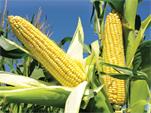Неполные придаточные предложения

| when (когда), while (в то время как), if (если), until (пока не), unless (если не), though (хотя) + причастие или прилагательное e.g. When accompained by high temperatures, heavy rainfall is unfavourable for wheat. |
Группы слов, состоящие из союзов when (когда), while (в то время как), if (если), until (пока не), unless (если не), though (хотя) и причастия или прилагательного, рассматриваются как неполные придаточные предложения.
Такую группу слов можно превратить в полное предложение, введя в нее недостающее подлежащее (то же, что и в главном предложении) и глагол to be в соответствующем времени, лице и числе.
e.g. When heavy rainfall is accompanied by high temperatures, it is unfavourable for wheat. Когда обильные осадки сопровождаются высокой температурой, они неблагоприятны для пшеницы.
LESSON 17.1. CORN
1. Study the Grammar Focus section of the unit: « Неполные придаточные предложения ».
2. Translate the following sentences containing clauses:
1. When grown continuously on the same field, corn can exhaust the soil in a short time.
1. If included in the rotation, perennial grasses should proceed cereals.
2. Though prepared properly, the seedbad didn't contain enough moisture for prompt germination of this crop.
3. When left rough, the soil is in better condition to hold moisture.
4. Unless applied at proper rate, this type of fertilizer may injure the crop.
5. While young, cotton plants are easily damaged by cool weather.
3. Identify by suffixes the parts of speech the following words belong to, provide their Russian equivalents.
1. require, requiring, required, requirement;
2. adept, adapted, adapting, adaptation, adaptability;
3. germinate, germinated, germinating, germination;
4. exist, existing, existence;
5. vary, varying, various, variously, variety, variability, variation.
Vocabulary Focus

| Handwrite the words and word combinations related to text A and give their Russian equivalents. Check them in the agronomy and soil science dictionaries. |
| extremely, variable, shape, pound, transpiration, to be high in, water-holding capacity, adequate, sunshine, vegetative growth, to manufacture, apart, advisable, livestock feed. |
 |
4. Read aloud and translate text A.
Text A
C or n
Corn is believed to have been a highly developed cultivated crop in the new world1 long before its discovery. The origin of corn is unknown since the plant has been found only under cultivation. How corn is more widely distributed over the world than any other cereal crop.
Corn is a member of the grass family. It's an extremely variable plant and there are a large number of varieties, varying greatly in size and shape.
Corn is warn-weather plant that requires high temperatures day and night during the growing season. It has been found to be highly susceptible to frost injury at any time of growth.
Actually corn requires a relatively small amount of water for each pound of dry matter produced, its high water requirement being due to the potential high acre production. When growing rapidly in July and August, corn needs much water because of the high rate of evaporation from the soil and transpiration from the leaves. Corn makes its beet growth if planted in a fertile, well-drained, loam soil. Besides, soils high in organic matter are ideal for this crap for they have a high water-holding capacity.
In addition to fertile soil and adequate moisture an abundance of sunshine is necessary for the plants to manufacture large quantities of food to be stored in the grain. Cool, cloudy weather results in heavy vegetative growth and low yields of grain.
The object is to plant corn at the death that will provide optimum soil temperature and water and result in rapid germination. Corn planting depth varies widely with the soil conditions and climate. As corn should be planted deep enough to place the seed in contact with warm moist soil, the usual depth is 2 to 3 inches in rows from 30 to 40 inches apart. The soil being rather cold, the depth of 1 to 1 1/2 inches may be advisable.
Corn is cultivated primarily to control weeds and to a less extent to conserve moisture and aerate the soil.
Corn is grown principally for grain, fodder, silage and posturing. Nearly 90% of the corn gray harvested is used directly as livestock feed. When cut for silage or harvested for fodder, corn does not usually leave the farms on which it is produced. Corn has numerous industrial uses. Its stems or leaves seem to have been used for making paper from ancient times2.
Notes to the text
1. the New World – Новый Свет;
2. from ancient times – с давних времен.
Comprehension activities
5. Find in text А :
1. неполные предложения (4-й и последний абзацы);
2. инфинитив в функции определения;
3. инфинитив, который переводится сказуемым в прошедшем времени (1-й и последний абзацы).
6. Fill in the gaps with the following words in the appropriate form: to vary, to vary in, to vary with, to vary from … to, variety, various, variable, variation.
1. The method of applying fertilizer ... … the crop drown and the type of fertilizer to be used.
2. The depth of corn seedingn … ... 1... 3 inches, depending on soil temperature.
3. The stem of corn plant is found to be more ... in size and height than that of any other cereal.
4. The external factors influencing plant growth are moisture, suitable temperature, oxygen, ..., nutrients, and light.
5. Water-holding capacity of different soils ... greatly, being the highest in soils rich in organic matter.
6. The first step in the improvement of any crop is the selection of the best ... for given conditions.
7. Fertilizing materials for this crop ... … nature and rate of application, being determined to a great extent by the character of the soil on which the crop is grown.
8. Great ... in the size of corn plant and in the time of its maturity is mainly due to the environment in which the crop is grown.
7 . Translate the sentences containing clauses.
1. If planted too deeply, the seedlings of this crap will have some difficulty in reaching the surface of the soil.
2. When present great amounts in the soil, nitrogen is known to cause lodging of most cereals.








